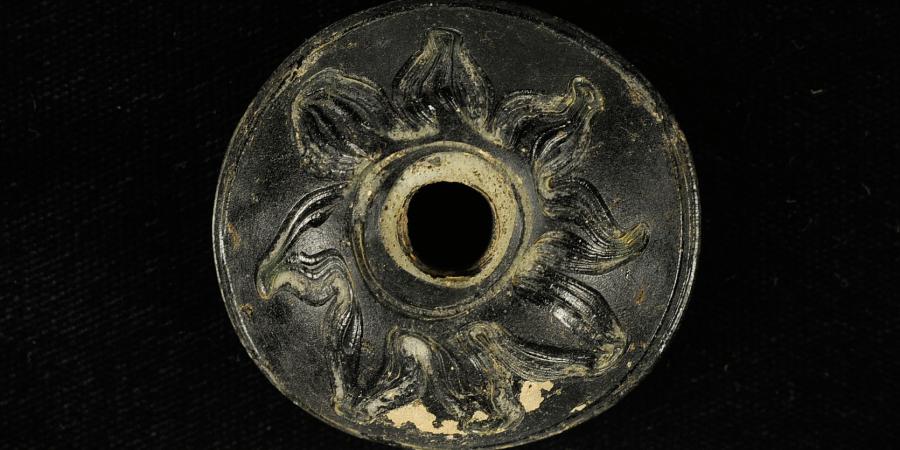As the third and final season of Operation Nightingale excavations at Avon Camp comes to a close, our very own Phil Andrews talks grave goods, a deviant burial, and a sword bead with no sword, in this round up of excavations at the Anglo-Saxon cemetery at Avon Camp
As part of our work with the Defence Infrastructure Organisation and Operation Nightingale, July 2023 saw the third and final season of excavations at this Anglo-Saxon cemetery. Initially revealed during an evaluation in 2020, immediately prior to Covid, the recent work followed the Operation Nightingale investigations at Barrow Clump between 2012–19, on the opposite side of the Avon valley, around 15 km north of Salisbury.
As with previous Operation Nightingale projects, a mixture of veterans and serving military personnel, joined by Army Widows, worked alongside a small group of experienced volunteers including Carlos and Janine Rocha, with Phil Andrews, Tom Dawkins and Jackie McKinley from Wessex Archaeology, and Richard Osgood of Defence Infrastructure Organisation.
Part of the Anglo-Saxon cemetery at Avon camp, graves are clustered by family connections, at the back right, a large grave enclosed by a ring ditch denotes someone important within the community. ©Wessex Archaeology
An Anglo-Saxon cemetery
Approximately 60 burials were excavated during 2021–3, probably representing the entire population of this small cemetery, which included males and females, adults, children and infants. These people will have belonged to a local community in the Avon valley, probably living around present-day Netheravon, the cemetery positioned on higher ground and in sight of the settlement below.
Ring ditches and family connections
Burial in the cemetery likely spanned only a few decades in the later 7th and early 8th centuries – up to a century earlier than that at Barrow Clump, though their use probably overlapped. The Avon Camp cemetery was focussed on two Anglo-Saxon ring ditches, each surrounding a large grave, presumably containing an important member of the community whose burial place was clearly marked out. However, neither was associated with any surviving grave goods or dress accessories such as buckles or brooches. Family groups can also be discerned in the layout and grouping of graves, and of particular interest is evidence for two small rectangular timber structures. These are unusual features, perhaps mausolea, one surrounding a grave containing two individuals, the other containing three graves, with the latest individual buried prone – that is face down. Often these so-called deviant burials are considered as outcasts, but was the intention in this case for the person to be facing members of their family previously buried there?
Square timber structures, possibly an example of mausolea, surround one grave containing two individuals. ©Wessex Archaeology

Three graves, with the latest individual buried face down- a so-called deviant burial ©Wessex Archaeology
Grave goods- necklaces, knives and an unusual sword bead
All but one of the graves were aligned approximately east–west, there being one exception for a north–south aligned grave which contained a male with a spear, the only weapon present in the cemetery. Around half of the individuals were buried with some of their possessions, knives used for a range of domestic purposes the most common objects present. Several of the females had necklaces of glass, amethyst and cowrie shell beads, silver wire rings and pendants; two necklaces also had small, pierced silver coins, these minted in the 680s and providing close dating for use of the cemetery. Other finds included iron shears and keys, bone and antler combs, and a stone for sharpening knives. However, almost the last discovery was the most unusual – a large, decorated, green glass sword bead probably used on the drawstring of the scabbard. It was no longer with a sword but had been placed under the arm of this female burial, probably in a bag, and likely an heirloom which was treated as an amulet.


Close dating for the cemetery was provided by these two small, pierced silver coins (pictured left) minted in 680AD ©Tom Westhead, Wessex Archaeology
The sword bead (pictured right) was probably an heirloom and treated as an amulet, seen here cleaned and processed by our conservator ©Wessex Archaeology
This find marked a perfect conclusion to another successful and enjoyable excavation, which has been supported by so many over the past three seasons. We'll miss going back to this incredible site, but as analysis of the bones and various objects commences, we look forward to seeing the results of the last three years put together in a publication.
The sun sets on the final excavations at Avon camp, ©Wessex Archaeology
